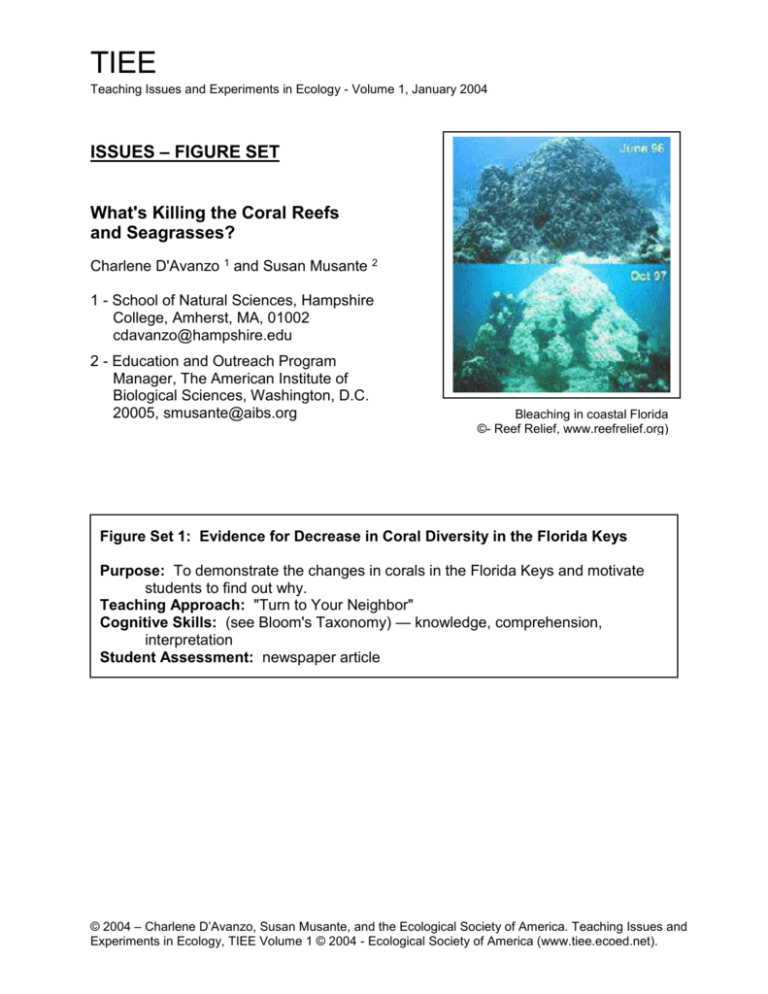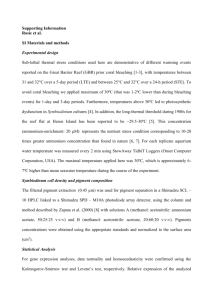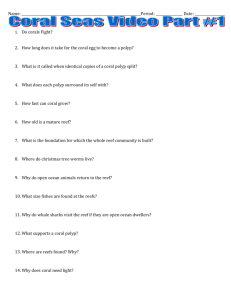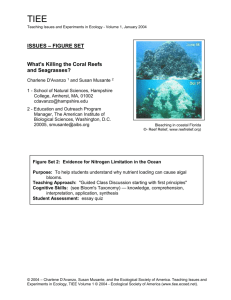coral_fig1 - Teaching Issues and Experiments in Ecology
advertisement

TIEE Teaching Issues and Experiments in Ecology - Volume 1, January 2004 ISSUES – FIGURE SET What's Killing the Coral Reefs and Seagrasses? Charlene D'Avanzo 1 and Susan Musante 2 1 - School of Natural Sciences, Hampshire College, Amherst, MA, 01002 cdavanzo@hampshire.edu 2 - Education and Outreach Program Manager, The American Institute of Biological Sciences, Washington, D.C. 20005, smusante@aibs.org Bleaching in coastal Florida ©- Reef Relief, www.reefrelief.org) Figure Set 1: Evidence for Decrease in Coral Diversity in the Florida Keys Purpose: To demonstrate the changes in corals in the Florida Keys and motivate students to find out why. Teaching Approach: "Turn to Your Neighbor" Cognitive Skills: (see Bloom's Taxonomy) — knowledge, comprehension, interpretation Student Assessment: newspaper article © 2004 – Charlene D’Avanzo, Susan Musante, and the Ecological Society of America. Teaching Issues and Experiments in Ecology, TIEE Volume 1 © 2004 - Ecological Society of America (www.tiee.ecoed.net). page 2 Charlene D’Avanzo and Susan Musante TIEE Volume 1, January 2004 BACKGROUND The only coral reef community in the continental US is in the waters off the southern tip of Florida. Stretching for more than 200 miles the Florida Keys and Florida Bay contain a mosaic of seagrass beds and corals with mangrove forests at the coastal edge. During the late 1980's and into the 1990's noticeable changes occurred in the Florida Keys area. In 1987 the seagrass Thalassia (turtle grass) began to disappear in Florida Bay. Blooms of phytoplankton became more common and severe. In the reef tract live coal coverage decreased and the corals were plagued with several diseases, some not seen before. Most researchers have looked to the Florida Bay watershed as the source of these problems. For decades freshwater flow from the Everglades into Florida Bay has been greatly changed; water has been diverted, retained, and polluted with herbicides and other agricultural chemicals. As a result of water diversions and also droughts, salinity in parts of the Bay has been reported to be as high as 70ppt (seawater is about 30 ppt). Another likely reason is increased nutrient loading (mainly from agriculture, sewage, and septic systems) to the Bay. Nearshore nutrient concentrations have risen and phytoplankton biomass plus water column turbidity has increased in some locations. Eutrophication, the increase of organic matter in water, can lead to low oxygen events; in the Florida Bay hypoxia (oxygen concentration > 2 ppm) and anoxia (no oxygen) have become more frequent. The Coral Reef Monitoring Project The figures student work with here are from the Coral Reef Monitoring Project (EPA 2000; www.reefrelief.org/coralreef/monitoring/project5.html) which was supported by the EPA. Because the Florida Keys National Marine Sanctuary and Protection Act designated over 2800 square miles of coastal waters as the Florida Keys National Marine Sanctuary, EPA was required to conduct a monitoring program. This extensive study included 40 reef sites where permanent station markers were established in 1995. Sampling began in 1996 and 160 stations in 40 sites were sampled through 2000. For the hard coral diversity surveys presented here two divers conducted simultaneous timed (15 min) inventories in 22 X 2 m stations and; number of species were counted as species diversity measurements. Diseases were also measured. Fig. 1A shows percent change in coral diversity from 1996-2000 in 3 locations: Upper Keys (north Key Largo to Conch Reef), Middle Keys (Alligator Reef to Molasses Reef), Lower Keys (Looe Key to Smith Shoal), and Tortugas (Dry Tortugas to Tortugas Bank). Fig. 1B is change in percent cover of corals in the same stations. Percent cover was measured in 60 frames of video images also taken at permanent locations. In addition to the data in Figure 1A and 1B, the EPA Executive Summary notes that: "When the first and last years data was compared, eight stony coral species Acropora cervicornis, Leptoseris cucullata, Millepora alcicornis, and Millepora complanata, Mycetophyllia danaana, ferox and lamarckiana and Porites porites) had experienced a significant loss. Only Agaricia fragilis showed a significant gain over the time span sampled... Over the 5 years, there was a significant increase in White © 2004 – Charlene D’Avanzo, Susan Musante, and the Ecological Society of America. Teaching Issues and Experiments in Ecology, TIEE Volume 1 © 2004 - Ecological Society of America (www.tiee.ecoed.net). TIEE ISSUES FIGURE SET Coral Reef and Seagrass Decline – Figure Set 1 page 3 Complex disease, and other diseases significantly increased. Overall, there were increases in the number of stations containing diseased coral, the number of species with disease, and the different types of diseases that were observed... The greatest mean percent stony coral cover was consistently observed at patch reef stations. Sanctuary-wide, a general trend of decline in stony coral cover was observed. For all years except 1996 to 1997, the decrease in mean percent coral cover was significant..." Other Studies by J.W. Porter et al. Other research shows similar results. Porter and Meier (1992) studied changes in coral species in 6 sites between Miami and Key West from 1984 to 1991. These sites were marked with stakes underwater and the same frame was re-photographed each time. During this 8 year period the number of coral species decreased at each station. Other data show that % cover, in addition to species number, decreased in these sites and that there was no recruitment of new, young corals over this time. In the abstract to the paper Porter and Meier say that "mortality of this magnitude is often associated with hurricane damage, but in this survey the losses occurred during a period without catastrophic storms." Sources of mortality identifiable in the photographs include 1) black band disease and 2) bleaching. The authors note that "loss rates of this magnitude cannot be sustained for protracted periods if the coral community is to persist in a configuration resembling historical reef community structure in the Florida Keys." More recent work by James W. Porter demonstrates the continuing spread of coral disease. The abstract of Porter et al. 2001 states that "In extensive surveys from Key Largo to Key West in 160 stations at 40 randomly chosen sites, there has been a dramatic increase in1) the number of locations exhibiting disease (82% of all stations are now affected, a 404% increase over 1996 values), 2) the number of species affected (85% of all species are now affected, a 218% increase over 1996 values), and 3) the rate of coral mortality." Porter et al. 2001 are cautious about identifying causal factors, saying in the abstract that "The central question of why so many corals are becoming simultaneously susceptible to a host marine pathogen remains unanswered". In the discussion section of the paper they note that areas closest to cities had more stations affected by disease, and therefore proximity to human centers may increase the likelihood of disease. Interestingly they do not themselves suggest that N and P exacerbate diseases and instead quote from a paper on infection of sea fans. The paper also includes a brief discussion of elevated temperature as a stress for corals. © 2004 – Charlene D’Avanzo, Susan Musante, and the Ecological Society of America. Teaching Issues and Experiments in Ecology, TIEE Volume 1 © 2004 - Ecological Society of America (www.tiee.ecoed.net). page 4 Charlene D’Avanzo and Susan Musante TIEE Volume 1, January 2004 STUDENT INSTRUCTIONS Examine Figures 1A and 1B: Turn to your neighbor and take 5 minutes to first describe and then interpret the data. Use the Step One - Step Two approach we have practiced in class. Be prepared to volunteer or be called on during our discussion. In Step One you first understand how the figure or table is set up (e.g. what the labels on the axes mean). You also need to have a pretty good idea of the experimental design - the question the scientists were asking and how they went about addressing it. Carefully describe the overall pattern in the data as well. In Step Two you can go on and attempt to interpret the data. For both steps write down any questions you have. Some information about this study: The only coral reef community in the continental US is in the waters off the southern tip of Florida. Stretching for more than 200 miles, the Florida Keys and Florida Bay contain a mosaic of seagrass beds and corals with mangrove forests at the coastal edge. During the late 1980's and into the 1990's noticeable changes occurred in the Florida Keys area. In the reef live coal coverage decreased and the corals were plagued with several diseases, some not seen before. Most researchers have looked to the Florida Bay watershed as the source of these problems. For decades freshwater flow from the Everglades into Florida Bay has been greatly changed; water has been diverted, retained, and polluted with herbicides and other agricultural chemicals. As a result of water diversions and also droughts, salinity in parts of the Bay has been reported to be as high as 70ppt (seawater is about 30 ppt). Another likely reason is increased nutrient inputs (mainly from agriculture, sewage, and septic systems) to the Bay. Nutrients (mainly nitrogen and phosphorus) stimulate the growth of phytoplankton (floating microscopic plants) in the water. The result is very turbid water which shades the corals (they need light to grow). In addition, when the phytoplankton die and sink to the bottom of the bay, waters can become anoxic (no oxygen) because bacteria use up oxygen when they consume all this organic matter. The EPA conducted this study from 1996-2000 in the Florida Keys National Marine Sanctuary. The data in Figs. 1 A and B are from permanent underwater stations in the Upper, Middle, and Lower Keys in Florida Bay. To get the coral diversity data (Fig. 1A), divers counted numbers of corals in 22 two meter squares at each station. The percent cover data (Fig. 1B) are from 60 frames per station of underwater videos. Address these questions: What is the overall pattern of change in both species diversity and percent cover at the 3 station locations in the Florida Keys? In what ways are these two measures of coral "health" different? Why might the results for these measures be different? Is one measure better than the other? Imagine that you are a diver floating over the Upper, Middle, and Lower Key reefs in 1996 and again in 2000. In what ways would the three locations look different in regard to both coral diversity and coverage of hard corals? Be as specific as you can be. © 2004 – Charlene D’Avanzo, Susan Musante, and the Ecological Society of America. Teaching Issues and Experiments in Ecology, TIEE Volume 1 © 2004 - Ecological Society of America (www.tiee.ecoed.net). TIEE ISSUES FIGURE SET Coral Reef and Seagrass Decline – Figure Set 1 page 5 FIGURES Figure 1A & 1B. Stations in which coral diversity (A) and percent cover (B) significantly decreased (black bars), increased (white bars), or was unchanged in the Upper Florida Keys (52 stations), middle Keys (44 stations), and lower keys (43 stations; EPA 2000). © 2004 – Charlene D’Avanzo, Susan Musante, and the Ecological Society of America. Teaching Issues and Experiments in Ecology, TIEE Volume 1 © 2004 - Ecological Society of America (www.tiee.ecoed.net). page 6 Charlene D’Avanzo and Susan Musante TIEE Volume 1, January 2004 NOTES TO FACULTY The two parts to Figure 1 are ideal for practice with data observation (knowledge) and interpretation. Give the groups enough time to discuss the figures - 5-10 minutes should be sufficient but they may need more. Before students discuss the figure give them a brief overview of the situation in the Florida Bay. Also, be sure they understand what "percent change" on the y-axes means. After students discuss the figures with their neighbors, ask for a volunteer (or call on someone) to describe the patterns they see in both figures. The most important point is that the pattern of change in regard to diversity is similar in the three locations but different in regard to cover. As the students bring out these and other points, write them down on an overhead or the board. The Student Instructions ask students why the two measures might show different results and if one is "better" than the other. They are also asked to contrast the reef appearance to a diver in the two years. Now go to the interpretations. In regard to diversity there are many reasons why coral diversity might decrease and reasonable guesses are hurricanes, water pollution of some sort or other changes in the water (e.g. temperature), anchor or diver damage, and grazing by fish and invertebrates. These and other changes to the Bay are described in the Overview of this Issue. After discussing this figure the students should be ready to hear you talk about what has happened in the Florida Keys. You can describe the situation in whatever detail seems best; there is a good deal of background information in this issues section and on the websites listed. It is important to emphasize that scientists disagree as to the cause of the coral disease and die-off and you can list and explain the various hypotheses. This would be a nice opportunity to discuss why scientists studying the same place and phenomenon can disagree with each other - and that there may not be a clear "right" and "wrong." This figure can also lead to a discussion about diversity. Coral diversity off Florida is not especially high, probably because the Keys are at the northern extent of coral distribution. Coral diversity increases with proximity to the equator where diversity of hard (reef building) corals is as high as 60 genera. Questions about diversity for discussion include: What might ecologists use as a measure of diversity? Imagine 10 species of corals in site 1 and site 2; in site 1 there are 10 individual corals for each species but in site 2 one species has 90 individuals and only 1 individual represents the other 9 species. Is the diversity of the 2 sites the same or not? Why is there so much interest in preserving tropical rain forests and coral reefs because they are highly diverse ecosystems? Is high diversity "good" and low diversity "bad"? © 2004 – Charlene D’Avanzo, Susan Musante, and the Ecological Society of America. Teaching Issues and Experiments in Ecology, TIEE Volume 1 © 2004 - Ecological Society of America (www.tiee.ecoed.net). TIEE ISSUES FIGURE SET Coral Reef and Seagrass Decline – Figure Set 1 page 7 Student Assessment: Newspaper Article. Write a 200-300 word description for a newspaper audience about the decrease in coral diversity in the Florida Bay. Include specific information about the loss of corals, how the data were obtained, several possible causes, and why this is interesting or important. Evaluating an Issue: How do you know whether it is working? On-going (also called formative) evaluation of the approaches your are using is critical to the success of student-active teaching. Why try out new ideas if you don't know whether or not they are working? This is a brief overview of formative evaluation. For more information, go to the Formative Evaluation essay in the Teaching Section. Course Goals: Formative evaluation only works if you have clearly described your course goals because the purpose of the evaluation is to assess whether a particular technique is helping students reach these goals. For instance, most of us have "learn important ecological concepts and information" as a course goal. If I reviewed the nitrogen cycle in a class, for evaluation I might ask students to sketch out a nitrogen cycle for a particular habitat or system. Each student could work alone in class. Alternatively, I might ask students to work in groups of 3 and give each group a different situation (e.g. a pond receiving nitrate from septic systems, an organic agricultural field, an agricultural field receiving synthetic fertilizer). The students could draw their flows on a large sheet of paper (or an overhead transparency) and present this to the rest of the class. The Minute Paper: Minute papers are very useful evaluative tools. If done well they give you good feedback quickly. Minute papers are done at the end of a class. The students are asked to respond anonymously to a short question that you ask. They take a minute or so to write their response in a 3x5 card or a piece of paper. You collect these and learn from common themes. In the next class it is important that you refer to one or two of these points so that students recognize that their input matters to you. The UW - FLAG site (www.wcer.wisc.edu/nise/cl1/flag/) gives a good deal of information about using minute papers including their limitations, how to phrase your question, step-by-step instructions, modifications, and the theory and research behind their use. LITERATURE CITED Coral reef monitoring project executive summary. EPA science advisory panel, Key Colony Beach, Dec. 5-6, 2000. www.reefrelief.org/coralreef/monitoring/project1.html Porter, J. W., and O. W. Meier. 1992. Quantification of loss and change in Floridian reef coral populations. American Zoologist 32: 625 - 640. Porter, J. W., P. Dunstan, W. C. Jaap, K. L. Patterson, V. Kosmynin, O. W. Meier, M E. Patterson, and M. Parsons. 2001. Patterns of spread of coral disease in the Florida Keys. Hydrobiologia 460: 1-24. © 2004 – Charlene D’Avanzo, Susan Musante, and the Ecological Society of America. Teaching Issues and Experiments in Ecology, TIEE Volume 1 © 2004 - Ecological Society of America (www.tiee.ecoed.net).









